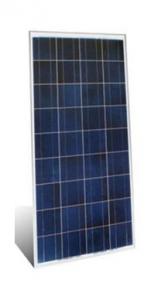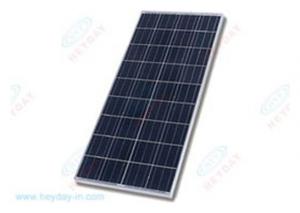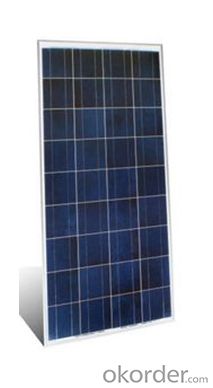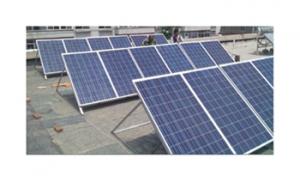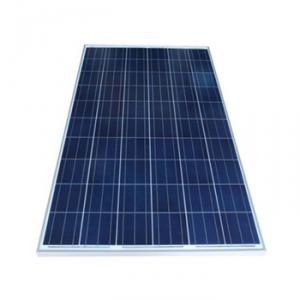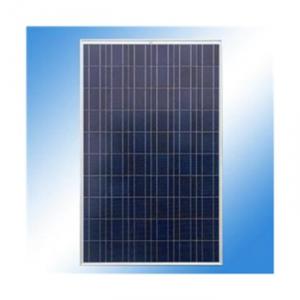Mppt Solar Controllers Compatible Poly-Crystalline 130W 156*156 Solar Modules
OKorder Service Pledge
OKorder Financial Service
You Might Also Like
Solar Module Descriptions:
Solar Power Modules (known as Photovoltaics - PV) can generate electricity for your home or business, either as part of a stand-alone solar power system, or for buildings already connected to the local electricity network.
Customers benefit from our progressive system innovations. Around the world, we meet our customers' desire for the greatest possible reliability, long-term performance and aesthetic integration. No matter which kind of roof – we always have the right solution.

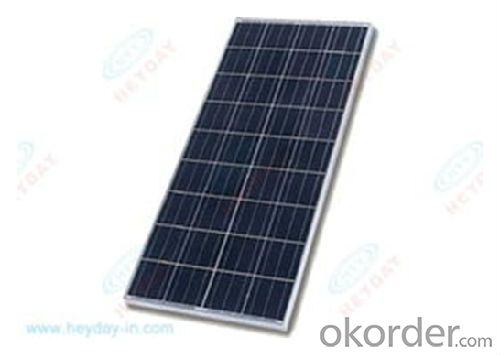
Electrical Characteristics
Max-power (W) | 130 |
Max-Power Voltage (V) | 17.9 |
Max-Power Current (A) | 7.30 |
Open-Circuit Voltage (V) | 21.74 |
Short-Circuit Current (A) | 8.05 |
Mechanical Characteristics
Cable type, Diameter and Length | 4mm2, TUV certified, 1000mm |
Type of Connector | Compatible with MC4 plug |
Arrangement of cells | 4*9 |
Cell Size | 156*156 |
Dimension | 1482*676*40 |
Weight | 12Kg |
Glass, Type and Thickness | High Transmission, Low Iron, Tempered Glass 3.2mm |
Features
Guaranteed positive tolerance 0/+5w ensures power output reliability
Strong aluminum frames module can bear snow loads up to 5400Pa and wind loads up to 2400Pa.
Excellent performance under low light environments (mornings evenings and cloudy days)
12 years for product defects in materials and workmanship and 25 years for 80% of warranted minimum power.
Certifications and standards: IEC 61215.
Manufactured according to International Quality and Environment Management System (ISO9001, ISO14100).
FAQ
Q: Do you have any MOQ limit?
Our MOQ is 200 pieces.
Q: How long is the warranty period for the solar modules?
15 years 90% of its nominal power rating.
25 years 80% of its nominal power rating
- Q: What is the communication protocol supported by a solar controller?
- The communication protocol supported by a solar controller is typically Modbus, which allows for data exchange and control between the solar controller and other devices in the solar power system.
- Q: How does a solar controller protect against short circuits?
- A solar controller protects against short circuits by constantly monitoring the current flowing through the system. It is equipped with built-in circuitry that detects any sudden increase in current, which could indicate a short circuit. When a short circuit is detected, the solar controller automatically interrupts the flow of current to prevent any damage to the solar panels or connected devices.
- Q: How does a solar controller prevent damage from reverse current flow in the load?
- A solar controller prevents damage from reverse current flow in the load by using a built-in blocking diode. This diode only allows current to flow in one direction, preventing any backflow of current from the load to the solar panels. By blocking the reverse current, the solar controller ensures that the load receives power from the solar panels without any risk of damage.
- Q: What is the difference between a PWM and MPPT solar controller?
- A PWM (Pulse Width Modulation) solar controller regulates the voltage output from the solar panels by rapidly turning the panels on and off. It is a basic and cost-effective solution suitable for small-scale solar systems. On the other hand, an MPPT (Maximum Power Point Tracking) solar controller maximizes the power output from the solar panels by constantly adjusting the voltage and current to find the optimum operating point, known as the maximum power point. This advanced technology is more efficient and effective, particularly for larger solar systems or those with varying weather conditions.
- Q: What is the maximum charging efficiency for a solar controller?
- The maximum charging efficiency for a solar controller is typically around 98%.
- Q: Can a solar controller be used with solar panel tracking algorithms?
- Yes, a solar controller can be used with solar panel tracking algorithms. The solar controller is responsible for regulating the flow of electricity between the solar panels and batteries, ensuring optimal charging and preventing overcharging. By integrating a solar panel tracking algorithm, which adjusts the position of the solar panels to maximize sunlight exposure, the controller can enhance the efficiency and output of the solar system.
- Q: What certifications or standards should I look for when selecting a solar controller?
- When selecting a solar controller, it is recommended to look for certifications such as the International Electrotechnical Commission (IEC) 62109 standard, which ensures safety and performance compliance. Additionally, certifications like CE, RoHS, and FCC can indicate compliance with European, environmental, and electromagnetic compatibility standards respectively. It is also advisable to consider controllers with certifications specific to the region where they will be used, as requirements may vary.
- Q: How does a solar controller prevent battery discharge during nighttime or low sunlight conditions?
- A solar controller prevents battery discharge during nighttime or low sunlight conditions by effectively blocking the flow of electricity from the battery to the solar panels. It senses the voltage of the battery and automatically interrupts the connection when it reaches a certain level, ensuring that the battery remains charged and preventing any energy loss.
- Q: What is the purpose of the load output on a solar controller?
- The load output on a solar controller serves the purpose of supplying power to a connected load, such as lights or small appliances, directly from the battery of the solar panel system. This feature allows for the utilization of solar energy when the sun is not shining or when the solar panel system cannot generate sufficient power to meet the load requirements. By directly connecting the load to the battery, the solar controller ensures a consistent and stable power supply to the load, thus maximizing the efficiency and reliability of the solar system. Moreover, the load output often incorporates various protection features, including overcurrent and overvoltage protection, to safeguard the connected load from potential damage. In summary, the load output on a solar controller enhances the functionality and versatility of a solar panel system by enabling the utilization of solar energy even in less favorable conditions for power generation.
- Q: What is the maximum voltage and current rating for a solar controller?
- The maximum voltage and current rating for a solar controller can vary depending on the specific model and manufacturer. However, in general, solar controllers can handle voltage ratings of up to 150 volts or even higher. When it comes to current ratings, they can typically handle currents of up to 60 amps or more. It is important to note that these ratings may differ based on the specific design and capabilities of the solar controller. Therefore, it is crucial to consult the manufacturer's specifications or user manual to determine the exact maximum voltage and current rating for a particular solar controller model.
Send your message to us
Mppt Solar Controllers Compatible Poly-Crystalline 130W 156*156 Solar Modules
OKorder Service Pledge
OKorder Financial Service
Similar products
Hot products
Hot Searches
Related keywords
